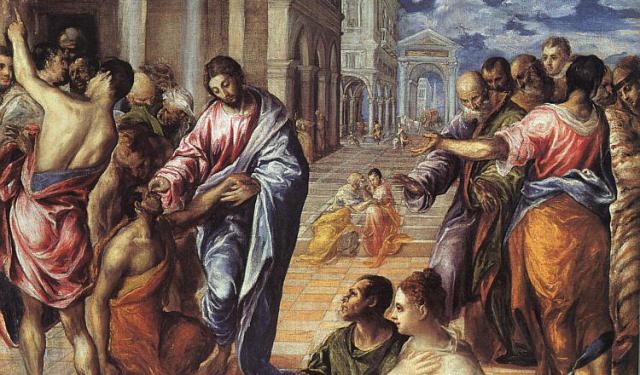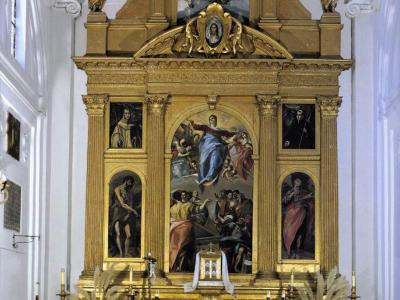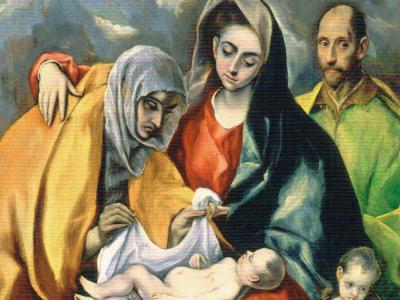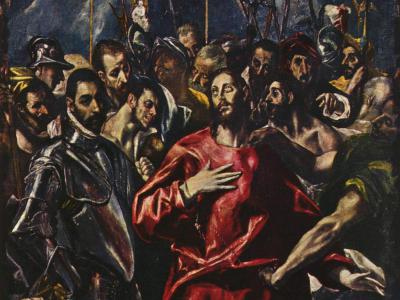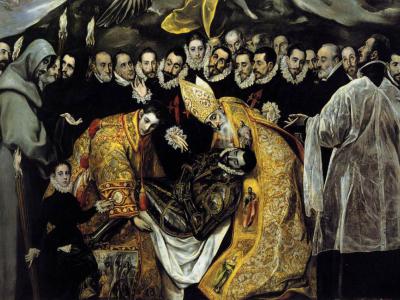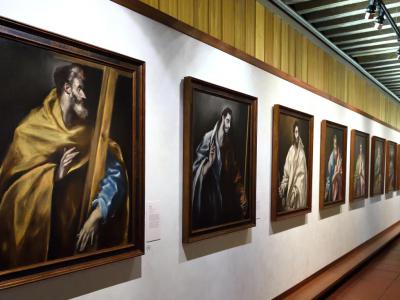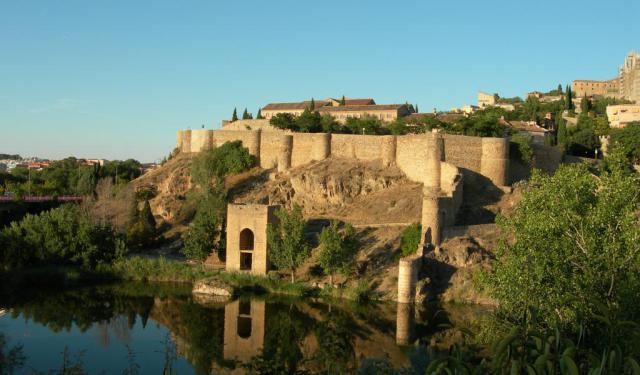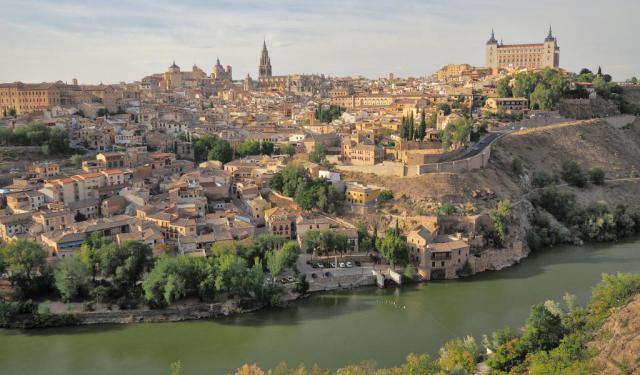El Greco's Masterpieces (Self Guided), Toledo
Domnnikos Theotokopoulos, most widely known as El Greco or "The Greek," was a Greek painter, sculptor, and architect of the Spanish Renaissance. El Greco was well ahead of his time. His dramatic and expressionistic style is regarded as a precursor of both Expressionism and Cubism of the 20th century.
El Greco was born in Crete, Greece, and studied painting in Italy. In 1577, he received a commission for nine paintings from the Monastery of Santo Domingo. That brought him to Toledo.
The city and the artist proved a good match. El Greco worked, married, raised a family, and lived in Toledo for the rest of his life. After his death, his remains are buried in the crypt beneath the Monastery of Santo Domingo. Today one can find El Greco's paintings throughout the city.
An altarpiece in the Santa Cruz Museum, fashioned by El Greco in 1613, tells of Mary's ascent to Heaven. She is borne up by billowing clouds of light, serenaded by angels. Byzantine faces, colors, and fluidity capture the Catholic mystery.
The Santa Cruz Museum also has The Crucifixion, Immaculate Conception, Annunciation, Holy Family, Assumption, and the Purification of the Temple and two views of 16th century Toledo, all by El Greco.
The Disrobing of Christ, finished in 1579, is in the Cathedral of Toledo. Christ is clad in red. Around him, his tormentors abuse him. They are in darkness. One man in yellow prepares the crucifix. Women look on in horror.
At the Church of Saint Tom is one of El Greco's most famous works, "The Burial of the Count of Orgaz." At the funeral of Don Gonzalo Ruiz de Toledo, Count of Orgaz, Saint Stephan, and Saint Augustine come down from Heaven to lay the Count to rest while his soul goes up.
In the El Greco Museum in the old Jewish quarter are 13 paintings of Christ and his disciples. Christ is flanked by six apostles to his right and six to his left. Judas' place is taken by Saint Paul.
Picasso proclaimed French painter Paul Cézanne to be the "father of us all." El Greco then is the grandfather.
El Greco was born in Crete, Greece, and studied painting in Italy. In 1577, he received a commission for nine paintings from the Monastery of Santo Domingo. That brought him to Toledo.
The city and the artist proved a good match. El Greco worked, married, raised a family, and lived in Toledo for the rest of his life. After his death, his remains are buried in the crypt beneath the Monastery of Santo Domingo. Today one can find El Greco's paintings throughout the city.
An altarpiece in the Santa Cruz Museum, fashioned by El Greco in 1613, tells of Mary's ascent to Heaven. She is borne up by billowing clouds of light, serenaded by angels. Byzantine faces, colors, and fluidity capture the Catholic mystery.
The Santa Cruz Museum also has The Crucifixion, Immaculate Conception, Annunciation, Holy Family, Assumption, and the Purification of the Temple and two views of 16th century Toledo, all by El Greco.
The Disrobing of Christ, finished in 1579, is in the Cathedral of Toledo. Christ is clad in red. Around him, his tormentors abuse him. They are in darkness. One man in yellow prepares the crucifix. Women look on in horror.
At the Church of Saint Tom is one of El Greco's most famous works, "The Burial of the Count of Orgaz." At the funeral of Don Gonzalo Ruiz de Toledo, Count of Orgaz, Saint Stephan, and Saint Augustine come down from Heaven to lay the Count to rest while his soul goes up.
In the El Greco Museum in the old Jewish quarter are 13 paintings of Christ and his disciples. Christ is flanked by six apostles to his right and six to his left. Judas' place is taken by Saint Paul.
Picasso proclaimed French painter Paul Cézanne to be the "father of us all." El Greco then is the grandfather.
How it works: Download the app "GPSmyCity: Walks in 1K+ Cities" from Apple App Store or Google Play Store to your mobile phone or tablet. The app turns your mobile device into a personal tour guide and its built-in GPS navigation functions guide you from one tour stop to next. The app works offline, so no data plan is needed when traveling abroad.
El Greco's Masterpieces Map
Guide Name: El Greco's Masterpieces
Guide Location: Spain » Toledo (See other walking tours in Toledo)
Guide Type: Self-guided Walking Tour (Sightseeing)
# of Attractions: 5
Tour Duration: 1 Hour(s)
Travel Distance: 2.0 Km or 1.2 Miles
Author: DanaOffice
Sight(s) Featured in This Guide:
Guide Location: Spain » Toledo (See other walking tours in Toledo)
Guide Type: Self-guided Walking Tour (Sightseeing)
# of Attractions: 5
Tour Duration: 1 Hour(s)
Travel Distance: 2.0 Km or 1.2 Miles
Author: DanaOffice
Sight(s) Featured in This Guide:
- Monasterio de Santo Domingo el Antiguo (Monastery of Saint Dominic the Old)
- Museo de Santa Cruz (Santa Cruz Museum)
- The Disrobing of Christ Painting at Toledo Cathedral
- Iglesia de Santo Tome (Church of Saint Thomas)
- Museo del Greco (El Greco Museum)
1) Monasterio de Santo Domingo el Antiguo (Monastery of Saint Dominic the Old)
The Monastery of Saint Dominic the Old may not shout for attention like Toledo’s mighty cathedral or fortress, but its story runs just as deep-stretching back over a thousand years. The site’s sacred life began in the 6th century, when the Visigoths built a church dedicated to Saint Leocadia alongside the city’s Roman walls. After the Muslim conquest of 711, that church was transformed into a mosque, a reminder of Toledo’s long role as a crossroads of faiths. When King Alfonso VI of León and Castile captured the city in 1085, he restored the building to Christian worship and reestablished it as a monastery. That act symbolized the return of Toledo to Christianity while still preserving traces of its Islamic past.
By the 14th century, the structure had fallen into disrepair, and its revival was entrusted to Gonzalo Ruiz de Toledo, Lord of Orgaz, a civic leader renowned for his piety and generosity to religious institutions. Under his patronage, the mosque’s old minaret was converted into a Mudéjar-style bell tower, with patterned brickwork and elegant arches that continue to fascinate modern admirers. Inside, the church took on a Latin-cross plan with three naves, a barrel vault, and a polygonal apse, later enriched by Gothic and Baroque chapels. The chancel was adorned with a magnificent 16th-century altar by sculptor Felipe Bigarny and paintings of the Passion and Resurrection by Francisco de Comontes.
The monastery is perhaps most famous for its connection with El Greco, the Greek-born painter who made Toledo his home. In 1577, fresh from Rome, he accepted his first major Spanish commission here. His masterpiece, The Burial of the Count of Orgaz (1586), still dominates the Chapel of the Conception, where the generous patron Gonzalo Ruiz de Toledo is depicted being laid to rest by Saints Stephen and Augustine. El Greco even painted himself and his son Jorge into the scene, creating a vivid intersection of art, faith, and local history.
For today’s visitors, a stop at the Monastery of Saint Dominic the Old offers more than a glimpse of Toledo’s artistic treasures. It invites you to wander through centuries of transformation-Visigothic, Islamic, Gothic, and Baroque-while standing in the very place where kings, saints, and artists left their mark on Spain’s story.
By the 14th century, the structure had fallen into disrepair, and its revival was entrusted to Gonzalo Ruiz de Toledo, Lord of Orgaz, a civic leader renowned for his piety and generosity to religious institutions. Under his patronage, the mosque’s old minaret was converted into a Mudéjar-style bell tower, with patterned brickwork and elegant arches that continue to fascinate modern admirers. Inside, the church took on a Latin-cross plan with three naves, a barrel vault, and a polygonal apse, later enriched by Gothic and Baroque chapels. The chancel was adorned with a magnificent 16th-century altar by sculptor Felipe Bigarny and paintings of the Passion and Resurrection by Francisco de Comontes.
The monastery is perhaps most famous for its connection with El Greco, the Greek-born painter who made Toledo his home. In 1577, fresh from Rome, he accepted his first major Spanish commission here. His masterpiece, The Burial of the Count of Orgaz (1586), still dominates the Chapel of the Conception, where the generous patron Gonzalo Ruiz de Toledo is depicted being laid to rest by Saints Stephen and Augustine. El Greco even painted himself and his son Jorge into the scene, creating a vivid intersection of art, faith, and local history.
For today’s visitors, a stop at the Monastery of Saint Dominic the Old offers more than a glimpse of Toledo’s artistic treasures. It invites you to wander through centuries of transformation-Visigothic, Islamic, Gothic, and Baroque-while standing in the very place where kings, saints, and artists left their mark on Spain’s story.
2) Museo de Santa Cruz (Santa Cruz Museum)
It is impossible to imagine Toledo without thinking of Domenikos Theotokopoulos, also known as El Greco ("The Greek"). El Greco won the hearts of Toledo in his time, and many of his works can be seen in the Santa Cruz Museum. The museum is in the old Hospital de Santa Cruz, founded in the 15th century by archbishop Pedro Gonzales de Mendoza.
The archbishop envisaged a centralized location to harbor orphaned and abandoned children in the city. The building is in a Greek cross plan with two of four courtyards completed. The vast Plateresque facade is by architect Alonso de Covarrubias. The crossing with ribbed vaults covers the museum's two main floors.
Four galleries, made by Enrique Egas, connect with the courtyards on two floors. Generally, Moorish traditions are combined with Flemish artistry and some Mannerist elements. The entablature is flanked by false columns with niches and stone canopies. The front pediment features Saint Helen discovering the True Cross.
The museum is dedicated to Archeology, Fine Arts, and Decorative Arts. Works by El Greco at the museum include The Immaculate Conception altarpiece and Veronica with the Holy Face.
The archbishop envisaged a centralized location to harbor orphaned and abandoned children in the city. The building is in a Greek cross plan with two of four courtyards completed. The vast Plateresque facade is by architect Alonso de Covarrubias. The crossing with ribbed vaults covers the museum's two main floors.
Four galleries, made by Enrique Egas, connect with the courtyards on two floors. Generally, Moorish traditions are combined with Flemish artistry and some Mannerist elements. The entablature is flanked by false columns with niches and stone canopies. The front pediment features Saint Helen discovering the True Cross.
The museum is dedicated to Archeology, Fine Arts, and Decorative Arts. Works by El Greco at the museum include The Immaculate Conception altarpiece and Veronica with the Holy Face.
3) The Disrobing of Christ Painting at Toledo Cathedral
The painting "The Disrobing of Christ" by Domenikos Theotocópoulos (El Greco) took two years to create. It was done on commission for the high altar of the sacristy of the Cathedral of Toledo. It was finished in 1579, but it was received not without controversy. The painting was valued at 950 ducats. El Greco was paid only 350.
The commissioners were displeased at some of the figures and colors in the painting. El Greco agreed to remove some of the figures but failed to do so. While the church fathers were not completely satisfied with the work, critics have acclaimed the painting as a "masterpiece of extraordinary originality."
The canvas is alive with color and movement. Christ, in the center of the vertically oriented scene, wears the purplish red robes of martyrdom. His expression is elevated and serene. His tormentors, all clad in dark colors or armor, press around him. They appear agitated. They point and gesticulate. The three Marys look on in anguish.
More than 17 versions of the painting are known to exist. The Disrobing immediately became hugely successful. Replica versions, including at least two by the Master, can be found in museums such as the National Gallery in Oslo, the Alte Pinakothek in Munich, and Upton House in Warwickshire, England.
The commissioners were displeased at some of the figures and colors in the painting. El Greco agreed to remove some of the figures but failed to do so. While the church fathers were not completely satisfied with the work, critics have acclaimed the painting as a "masterpiece of extraordinary originality."
The canvas is alive with color and movement. Christ, in the center of the vertically oriented scene, wears the purplish red robes of martyrdom. His expression is elevated and serene. His tormentors, all clad in dark colors or armor, press around him. They appear agitated. They point and gesticulate. The three Marys look on in anguish.
More than 17 versions of the painting are known to exist. The Disrobing immediately became hugely successful. Replica versions, including at least two by the Master, can be found in museums such as the National Gallery in Oslo, the Alte Pinakothek in Munich, and Upton House in Warwickshire, England.
4) Iglesia de Santo Tome (Church of Saint Thomas) (must see)
The Church of Saint Thomas sits in the heart of Toledo and holds nearly a millennium of history within its walls. Its origins go back to the aftermath of 1085, when King Alfonso VI of León reclaimed the city from Muslim rule. Instead of demolishing the mosque that already stood on the site, he consecrated it as a Christian church-a common practice in reconquered cities, where sacred spaces were repurposed rather than destroyed. By the 14th century, however, the building had fallen into disrepair. The task of restoring and expanding it fell to Ruiz de Toledo, Lord of Orgaz and then mayor of the city. A generous patron of the Church, Ruiz de Toledo commissioned a reconstruction in which the former minaret was transformed into a graceful Mudéjar-style bell tower, its brick patterns and horseshoe arches preserving a hint of the site’s Islamic past within a Christian setting.
The architecture of the church reveals Toledo’s distinctive cultural layering. The layout follows the Latin cross, with three naves, a barrel vault, and a polygonal apse. The side chapels display ornate Baroque altarpieces, while the main chapel combines Gothic structure with Mudéjar decoration, crowned by a dome shaped like the eight-pointed Islamic Rub el Hizb star. A 16th-century baptismal font survives, and a later 19th-century chapel houses The Incredulity of Saint Thomas, a moving canvas by Vicente Portaña.
Yet what truly draws visitors from around the world is El Greco’s celebrated masterpiece, The Burial of the Count of Orgaz. Commissioned in 1586 to honor Ruiz de Toledo, the painting dramatizes the miraculous moment when Saints Stephen and Augustine descended from heaven to lay the Count in his grave. El Greco inserted his own likeness and that of his young son into the crowd of mourners, blending personal presence with historical memory in a swirl of elongated figures and luminous color. The painting remains one of the defining works of European Mannerism and a testament to Toledo’s role as the adopted home of the Cretan-born artist.
Saint Thomas offers more than a church visit. It is a vivid page from Spain’s past, where Roman, Islamic, Gothic, Renaissance, and Baroque traditions all converge. Standing within its star-vaulted nave, you glimpse the city’s shifting identities-and the extraordinary artistry that has made Toledo a cultural treasure.
The architecture of the church reveals Toledo’s distinctive cultural layering. The layout follows the Latin cross, with three naves, a barrel vault, and a polygonal apse. The side chapels display ornate Baroque altarpieces, while the main chapel combines Gothic structure with Mudéjar decoration, crowned by a dome shaped like the eight-pointed Islamic Rub el Hizb star. A 16th-century baptismal font survives, and a later 19th-century chapel houses The Incredulity of Saint Thomas, a moving canvas by Vicente Portaña.
Yet what truly draws visitors from around the world is El Greco’s celebrated masterpiece, The Burial of the Count of Orgaz. Commissioned in 1586 to honor Ruiz de Toledo, the painting dramatizes the miraculous moment when Saints Stephen and Augustine descended from heaven to lay the Count in his grave. El Greco inserted his own likeness and that of his young son into the crowd of mourners, blending personal presence with historical memory in a swirl of elongated figures and luminous color. The painting remains one of the defining works of European Mannerism and a testament to Toledo’s role as the adopted home of the Cretan-born artist.
Saint Thomas offers more than a church visit. It is a vivid page from Spain’s past, where Roman, Islamic, Gothic, Renaissance, and Baroque traditions all converge. Standing within its star-vaulted nave, you glimpse the city’s shifting identities-and the extraordinary artistry that has made Toledo a cultural treasure.
5) Museo del Greco (El Greco Museum) (must see)
The El Greco Museum preserves the memory of one of Spain’s most distinctive painters, Domenikos Theotokopoulos, universally known as El Greco. Born in Crete and trained in Venice and Rome, he arrived in Spain in the 1570s. Toledo, then a thriving religious and cultural capital, became his permanent home. The city’s dramatic landscapes and spiritual atmosphere suited his bold artistic style, defined by elongated figures, vibrant colors, and an intensity that baffled many of his contemporaries but later influenced masters such as Picasso, Cézanne, and even modern expressionists.
The museum itself has an unusual history. Despite its name, El Greco never actually lived in the building. In the early 20th century, the Marquis of Vega-Inclán, a passionate patron of Spanish culture, purchased a cluster of houses in Toledo’s former Jewish quarter. With architect Eladio Laredo, he transformed them into a reconstruction of a 16th- and 17th-century residence reminiscent of where El Greco might have lived. This project was part of a broader effort by the Marquis to preserve Spain’s cultural heritage; he also created the Museum of Romanticism in Madrid and restored Cervantes’ house in Valladolid. The El Greco Museum opened its doors in 1911, bringing together many of the artist’s scattered works and later, in 1964, was officially designated the Museum of the Sephardic heritage as well, ensuring its protection under the state.
Inside, the museum houses more than 3,000 objects, from Talavera de la Reina ceramics to antique furnishings and beautifully decorated Moorish-style wooden ceilings, which reflect the city’s long history of cultural fusion. Yet the most dazzling treasures are El Greco’s own canvases. The museum preserves an extraordinary series of thirteen portraits of Christ and the Apostles, painted between 1610 and 1614, alongside masterpieces such as The Tears of Saint Peter and View and Plan of Toledo. Together, these works reveal the artist’s visionary approach, bridging Byzantine tradition with Renaissance and mannerist experimentation.
For visitors, the El Greco Museum is not only an art gallery but a time capsule of Toledo’s Golden Age. To explore its rooms and courtyards is to step into the world that inspired El Greco, where religion, art, and history intertwined to leave a legacy that still captivates travelers today.
The museum itself has an unusual history. Despite its name, El Greco never actually lived in the building. In the early 20th century, the Marquis of Vega-Inclán, a passionate patron of Spanish culture, purchased a cluster of houses in Toledo’s former Jewish quarter. With architect Eladio Laredo, he transformed them into a reconstruction of a 16th- and 17th-century residence reminiscent of where El Greco might have lived. This project was part of a broader effort by the Marquis to preserve Spain’s cultural heritage; he also created the Museum of Romanticism in Madrid and restored Cervantes’ house in Valladolid. The El Greco Museum opened its doors in 1911, bringing together many of the artist’s scattered works and later, in 1964, was officially designated the Museum of the Sephardic heritage as well, ensuring its protection under the state.
Inside, the museum houses more than 3,000 objects, from Talavera de la Reina ceramics to antique furnishings and beautifully decorated Moorish-style wooden ceilings, which reflect the city’s long history of cultural fusion. Yet the most dazzling treasures are El Greco’s own canvases. The museum preserves an extraordinary series of thirteen portraits of Christ and the Apostles, painted between 1610 and 1614, alongside masterpieces such as The Tears of Saint Peter and View and Plan of Toledo. Together, these works reveal the artist’s visionary approach, bridging Byzantine tradition with Renaissance and mannerist experimentation.
For visitors, the El Greco Museum is not only an art gallery but a time capsule of Toledo’s Golden Age. To explore its rooms and courtyards is to step into the world that inspired El Greco, where religion, art, and history intertwined to leave a legacy that still captivates travelers today.
Walking Tours in Toledo, Spain
Create Your Own Walk in Toledo
Creating your own self-guided walk in Toledo is easy and fun. Choose the city attractions that you want to see and a walk route map will be created just for you. You can even set your hotel as the start point of the walk.
Toledo's Ancient Walls, Gates and Bridges
Other than its signature “Toledo steel”, the Spanish city of Toledo is known for its historic architecture, particularly the ancient mammoth fortifications – a testament to the strength of the city that has maintained its borders for well over a thousand years.
Toledo's soaring walls were first built by the Romans in the 3rd century AD and then further expanded, over the following... view more
Tour Duration: 1 Hour(s)
Travel Distance: 2.1 Km or 1.3 Miles
Toledo's soaring walls were first built by the Romans in the 3rd century AD and then further expanded, over the following... view more
Tour Duration: 1 Hour(s)
Travel Distance: 2.1 Km or 1.3 Miles
Toledo Introduction Walking Tour
Roman historian Livy didn’t bother with flattery. To him, Toledo was “a small city, but fortified by location”-and he wasn’t wrong. Apart from its governance over the Tagus River, the city has long been known as the “City of the Three Cultures”-a place where Christianity, Islam, and Judaism all left visible marks, even if coexistence was not always peaceful. Its name comes from the... view more
Tour Duration: 2 Hour(s)
Travel Distance: 3.2 Km or 2 Miles
Tour Duration: 2 Hour(s)
Travel Distance: 3.2 Km or 2 Miles
The Most Popular Cities
/ view all
